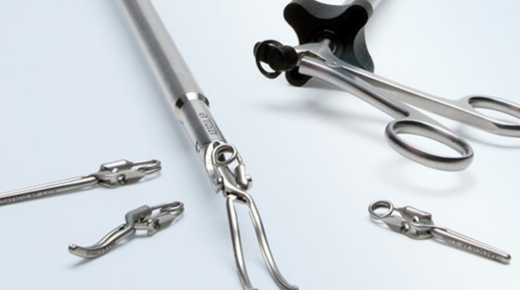1. Introduction to Laparoscopic Surgery Instruments
Laparoscopic surgery, also known as minimally invasive surgery, relies on specialized instruments for precise and minimally invasive procedures. Understanding the names and functions of these instruments is essential for surgeons performing laparoscopic procedures.
2. Trocars
Trocars are long, thin tubes used to create entry ports in the abdominal wall during laparoscopic surgery. They allow for the insertion of other instruments and the passage of cameras for visualization.
3. Laparoscope
The laparoscope is a long, thin tube with a camera and light source attached to one end. It is inserted through a trocar to provide a magnified view of the surgical site on a monitor.
4. Graspers
Graspers, also known as forceps, are used to grasp and manipulate tissues and organs during laparoscopic surgery. They come in various shapes and sizes to accommodate different surgical needs.
5. Scissors
Laparoscopic scissors are used to cut tissues and sutures during surgery. They are designed to fit through small incisions and provide precise cutting capabilities.
6. Dissectors
Dissectors are instruments used to separate and dissect tissues during laparoscopic procedures. They help surgeons navigate through layers of tissue with minimal trauma.
7. Needle Holders
Needle holders are specialized instruments used to hold and manipulate needles during suturing in laparoscopic surgery. They provide the precision and control needed for accurate stitching.
8. Clip Appliers
Clip appliers are used to apply surgical clips to blood vessels or other structures during laparoscopic procedures. These clips help control bleeding and secure tissues.
9. Retractors
Retractors are used to hold tissues and organs out of the way to provide better visibility and access during laparoscopic surgery. They come in various designs for different surgical needs.
10. Suction and Irrigation Devices
Suction and irrigation devices are used to remove fluids and debris from the surgical site during laparoscopic procedures. They help maintain a clear field of view for the surgeon.
11. Electrocautery Devices
Electrocautery devices use electrical energy to cut and coagulate tissues during laparoscopic surgery. They help control bleeding and minimize tissue damage.
12. Harmonic Scalpel
The harmonic scalpel uses ultrasonic vibrations to cut and coagulate tissues during laparoscopic surgery. It provides precise cutting with minimal thermal damage to surrounding tissues.
13. Knot Pushers
Knot pushers are used to push knots through tissues during laparoscopic suturing. They help secure sutures in place and ensure a tight knot for effective closure.
14. Endoscopic Staplers
Endoscopic staplers are used to create and secure tissue closures during laparoscopic surgery. They provide a faster and more efficient alternative to traditional suturing methods.
15. Babcock Graspers
Babcock graspers are specialized graspers with atraumatic jaws used to grasp delicate tissues during laparoscopic surgery. They minimize tissue trauma and ensure gentle handling.
16. Maryland Dissectors
Maryland dissectors are versatile instruments used for dissection and manipulation of tissues during laparoscopic surgery. They have a long, curved shaft with a fine tip for precise control.
17. Ligasure Device
The Ligasure device is a bipolar electrothermal vessel sealing system used to seal blood vessels during laparoscopic surgery. It provides rapid and secure vessel sealing with minimal tissue damage.
18. Endoscopic Needle Drivers
Endoscopic needle drivers are used to manipulate needles and suture materials during laparoscopic suturing. They provide the dexterity and control needed for precise stitching.
19. Endoscopic Knot Tiers
Endoscopic knot tiers are specialized instruments used to tie knots during laparoscopic suturing. They facilitate the creation of secure and tight knots in confined spaces.
20. Endoscopic Clip Appliers
Endoscopic clip appliers are used to apply surgical clips to blood vessels or tissues during laparoscopic surgery. They allow for precise clip placement in hard-to-reach areas.
21. Endoscopic Graspers
Endoscopic graspers are used to grasp and manipulate tissues and organs during laparoscopic surgery. They come in various designs for different surgical needs and provide precise control.
22. Endoscopic Scissors
Endoscopic scissors are used to cut tissues and sutures during laparoscopic procedures. They are designed to fit through small incisions and provide precise cutting capabilities.
23. Endoscopic Retractors
Endoscopic retractors are used to hold tissues and organs out of the way to provide better visibility and access during laparoscopic surgery. They come in various designs for different surgical needs.
24. Endoscopic Suction and Irrigation Devices
Endoscopic suction and irrigation devices are used to remove fluids and debris from the surgical site during laparoscopic procedures. They help maintain a clear field of view for the surgeon.
25. Conclusion
Laparoscopic surgery instruments play a crucial role in performing minimally invasive procedures with precision and efficiency. Surgeons rely on these specialized tools to navigate through tissues and organs, manipulate structures, and achieve optimal surgical outcomes for their patients.




